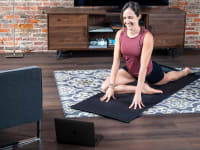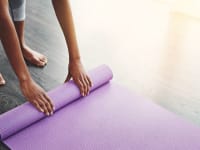Lululemon’s pricey new yoga mat offers a lot—but it’s not perfect
The Take Form claims to perfect your practice with added texture.
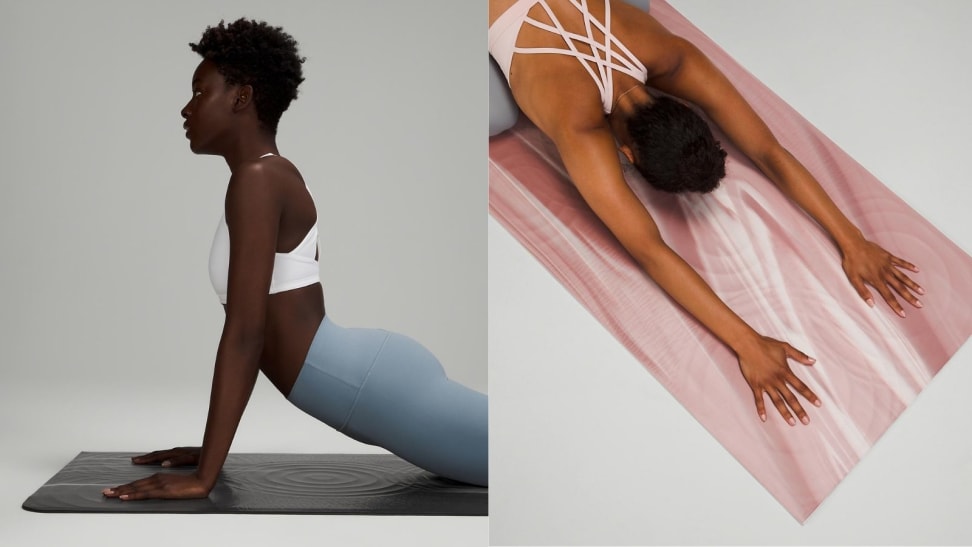 Credit:
Lululemon
Credit:
Lululemon
Products are chosen independently by our editors. Purchases made through our links may earn us a commission.
I've been practicing yoga for a solid 15 years, so I've seen and used it all when it comes to mats: thin and tiny roll-up travel options, surfaces thick enough to support the weight of a treadmill, and cheap dollar store mats that I got because they came in bright colors and I could afford to get all five. It wasn’t until more recently that I realized how profound an impact these thin, rubbery surfaces have on my practice. A tactile, well cushioned mat can be the missing piece to help you master a tricky balancing pose or support your joints when you're rooting down into the ground. Since that grand—albeit delayed—discovery, I’ve been faithful to my Lululemon Reversible mat, which provides a solid balance of grip, give, and sturdiness as our best yoga mat.
As a dedicated Lulu fanatic, I leapt at the opportunity to test out the brand's new Take Form mat, which features inventive textured circles that allegedly help you keep your balance when you practice. Will it replace my 5mm Reversible mat for good, or, er, Take Form in my closet with my several other abandoned mats?
What is the Take Form yoga mat?
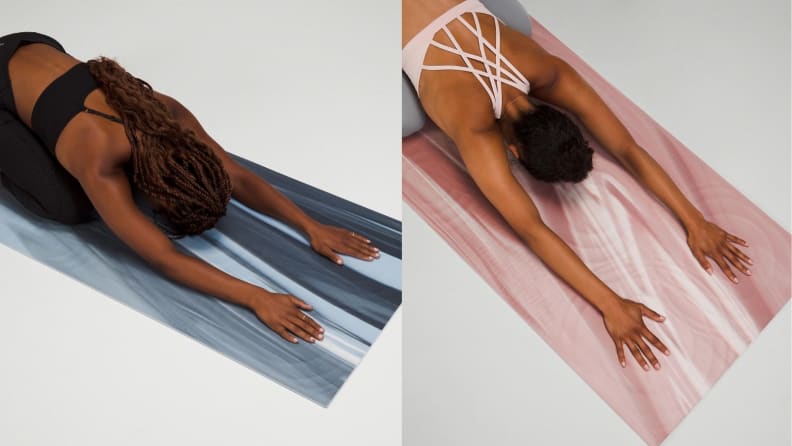
Lululemon's Take Form mat uses 3D technology to guide you to the all the right places.
The Take Form mat is one of Lululemon’s nine mats designed for yoga. It’s made of natural rubber with a porous polyurethane surface that feels both smooth and grippy at the same time. The mat is 71 inches long, 26 inches wide, 5 millimeters (or about 0.2 inches) thick—the same as my Reversible mat's measurements—and weighs 4.9 pounds, which is lighter than the 5.24-pound Reversible mat. The Take Form's main allure lies in its "3D rings," or textured markings strategically placed around the perimeter of the mat. They’re intended to allow you to align your hands and feet without having to look down, which the brand claims help you stay focused and get the most of your workout. It costs $118 if you get it in a solid color and $128 if you go for a tie-dye variation.
With specs like that, and a devoted built-in following surrounding Lululemon, it’s no surprise the mat sold out two weeks after its launch on March 26. Find out why it might be worth adding to your fitness routine now that it’s back in stock.
What's the deal with those 3D rings?
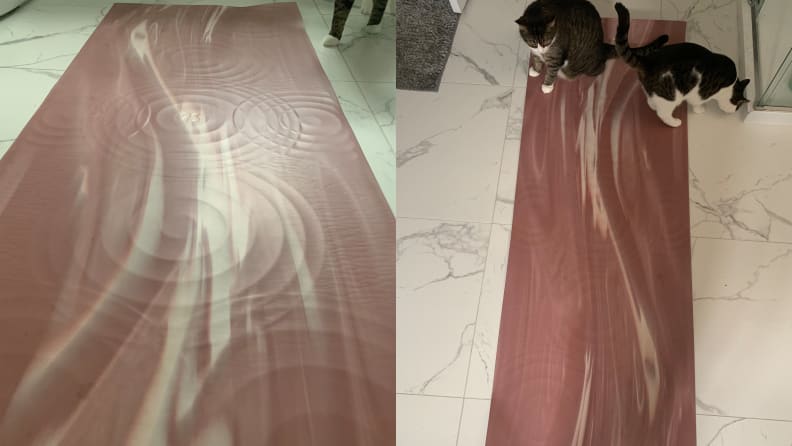
The circles on the mat give it extra texture (and makes for a good cat perch).
The rings look like the ripples that form when you throw a stone into a pond. The inner ring is where you’re expected to plant your hands or feet, and its five larger, outer rings are intended to help gently guide you there. Because the rest of the mat’s surface has a tacky texture, the rings don’t stand out as much I expected from a tactile perspective, at least for me. I have calloused palms, heels and balls of my feet, further preventing me from detecting those nuances in the mat. If you have baby-soft skin, you might be more receptive to those subtle shifts in mat texture.
What I loved about the Take Form mat
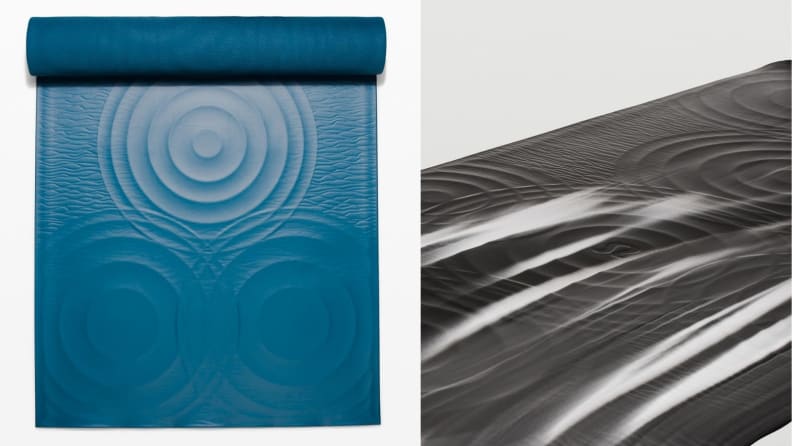
Coming in solid and marbled colors, the Take Form mat is both aesthetically pleasing and practical.
The Take Form mat has a grip unlike any other mat I've used. This is essential for someone like me who sweats a lot, as I’m still traumatized by the one time I rolled my ankle on a particularly slick mat. The mat feels almost cemented beneath my feet, which helps me stand strong in Triangle and Warrior poses. The grip even supports sock-wearing (a usual no-no on yoga mats), so workouts require socks like barre could work on this mat. This next-level grip also came in handy when I took the mat to practice outside—post-rain, the grass was damp, yet I felt glued to the ground, bone-dry, and like I was on my own private lily pad in a pond (not unlike the design of the mat itself). That grip also acts as a sort of built-in adhesive, allowing the mat to stay rolled up while in storage.
I normally associate strong sticking power with an uncomfortably firm surface—natural rubber is tactile but also quite dense. The Take Form has just enough give to alleviate two common problem areas. I have chronic knee pain from years of running, and sitting on all fours with my knees pressed to the mat in preparation for Cat-Cow and Bird-Dog can be extremely comfortable. The cushion-y rubber absorbed some of the shock common in plyometric movements like squat jumps or lunges, which took pressure off my ankles and knees. Also, as a newbie headstander, my precious noggin felt protected when my forearms and shoulders gave out while inverted.
The Take Form is 3 inches longer than a standard mat, which are usually 68 inches in length. When I think back to my dollar store mat days, the couple extra inches of space on the Take Form mat makes me feel like I'm spending the day in a roomy hotel after years in a cramped apartment. The difference is that much more discernible when I’m using the mat for workouts that involve lifting weights or lateral and longitudinal movements like traveling pushups and long jumps. I should note that the brand does not recommend using weights or running shoes on the mat, but I a) live dangerously, and b) often precede yoga practices with weighted HIIT sessions and dread the idea of sullying two mats, the same way I reuse a dish multiple times in a row to avoid that dreaded tall stack of dirty dishes in the sink.
Unlike the Reversible mat, which I keep far away from weights, running shoes, basically anything that can tamper with its surface, the firm Take Form mat doesn’t crease under the weight of the dumbbells. In the rare occurrence it gets creases (say, during an elevated push-up holding dumbbells), it bounces right back to its initial form.
Another plus: Fellow pet owners, you might actually let your furry family members hit the mat with this one. Contrary to every other yoga mat I’ve owned, my cats have not been able to dig their nails into the Take Form mat and thus scatter its remnants all over my floor. Whenever I notice an accumulation of pet dander or hair on it, I simply tip the mat over, sweep up the fuzz, and disinfect the surface with a damp cloth and gentle all-purpose cleaner.
Despite the mat’s generous dimensions, it’s not any heavier than what I’m used to. Because it's 0.25 pounds lighter than the Reversible mat, it’ll likely feel a tad lighter on my back once studios reopen here in Montreal when I’ll be toting around my mat a couple times a week.
What I didn't love about the Take Form mat
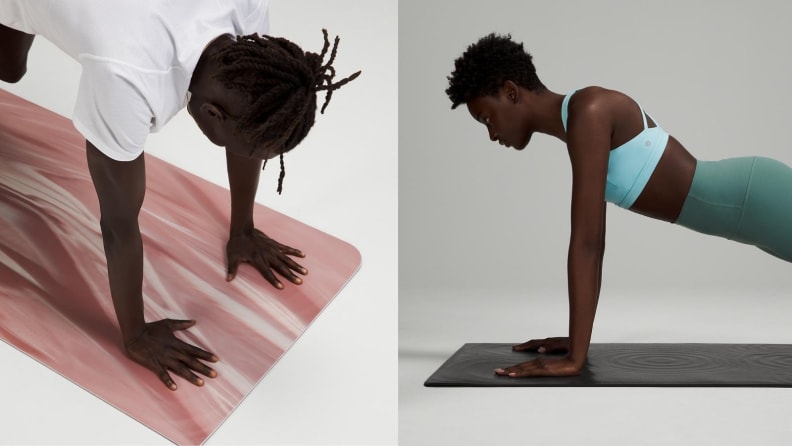
The Take Form mat may help you feel more secure during at-home self-guided workouts.
While the Take Form is rife with stellar qualities, it has its flaws, too. It has a strong odor when it's first unwrapped, so I recommend leaving the mat unrolled for a few days in a well-ventilated area after receiving it. I have yet to take the Take Form to the studio, so I practice in my bedroom. After an hour of power yoga in 68-degree room temperature, my beads of sweat decorated the surface of the mat not unlike a Jackson Pollock painting—and stayed there for about an hour. I can only imagine how much more drenched the mat would have gotten in an in-studio Bikram class hovering around 105 degrees in 40 percent humidity. The grip held up despite the sweat, but the mat made lots of noise when I switched poses or performed any type of sliding motion, sometimes disabling me from sliding at all. I also felt a little too rooted in some postures and had to work hard to make a transition.
While I appreciate the 3D rings as a lovely display of attention to detail, they are too indistinguishable to my touch to have any real difference on my practice. Even so, you can see them, which isn't always a good thing—when we tested the Take Form in our roundup of yoga mats, we also found that the rings make the mat look a little lumpy and disheveled, unlike the smooth, silky surface of the Reversible mat. Reviews on the site are mixed: Some customers say the rings prevent you from looking down to adjust, and others agree they don’t make much of an impact. And when I’m following an instructor-led routine, limb placement on the mat isn’t quite up to me, rendering the rings futile. At 5 feet 3 inches tall, I’m pretty short, so my hands and feet don’t align with the mat’s rings in, for example, a proper Downward Dog anyway. Additionally, the rings fail to account for postures that are performed hands- or feet-free, like Bow Pose or Happy Baby. When I (surprisingly) felt the rings beneath my pelvis and tailbone, respectively, I thought to myself, “This is probably not what Lululemon had in mind.”
I imagine the Take Form's rings could work for someone who tends to overthink their alignment at the detriment of a fluid practice. Given the shift toward home workouts, those 3D rings may provide structural support for someone used to a bit of postural guidance from an instructor. But that someone just isn’t me. If you're really into the idea of tactile guidance as you practice, you may also want to consider the $140 Liforme mat—our best upgrade pick in our test of yoga mats—which has lines etched into its surface of the mat to help you find alignment, and these work regardless of the user's height.
Should you get the Take Form mat?
While I thought my Reversible mat would be my “one and only” going forward, I’m thrilled I found a mat like the Take Form that exceeds it in the grip department and makes me feel stable as I perform more dynamic movements. If I can finally get over my aversion to disinfecting two mats and using them both, I can see the benefits to rotating them: The Take Form gets my attention when I need to feel glued to the floor, and the Reversible provides cushion on sore joints.
Still, whether or not to get it depends on your needs and your budget. The grip, cushion, and durability help the Take Form hold its own against the Reversible mat, but at around $130, it's a big purchase and $50 more than the also-not-cheap Reversible. Because of this, I recommend sticking with the Reversible mat if you just need a good, solid yoga mat to keep on hand for years and years, and the Take Form if you want additional grip and the possibility of some tactile guidance.
If you're into the Take Form, be sure to grab yours, stat. Because it went out of stock so quickly upon its release, I’m going to go out on a (yoga-balanced) limb and say it might not stay on shelves for long.

